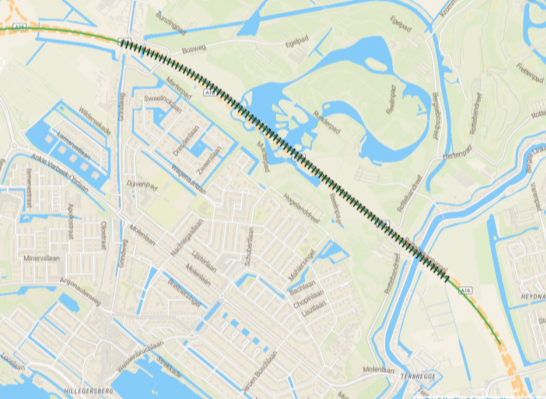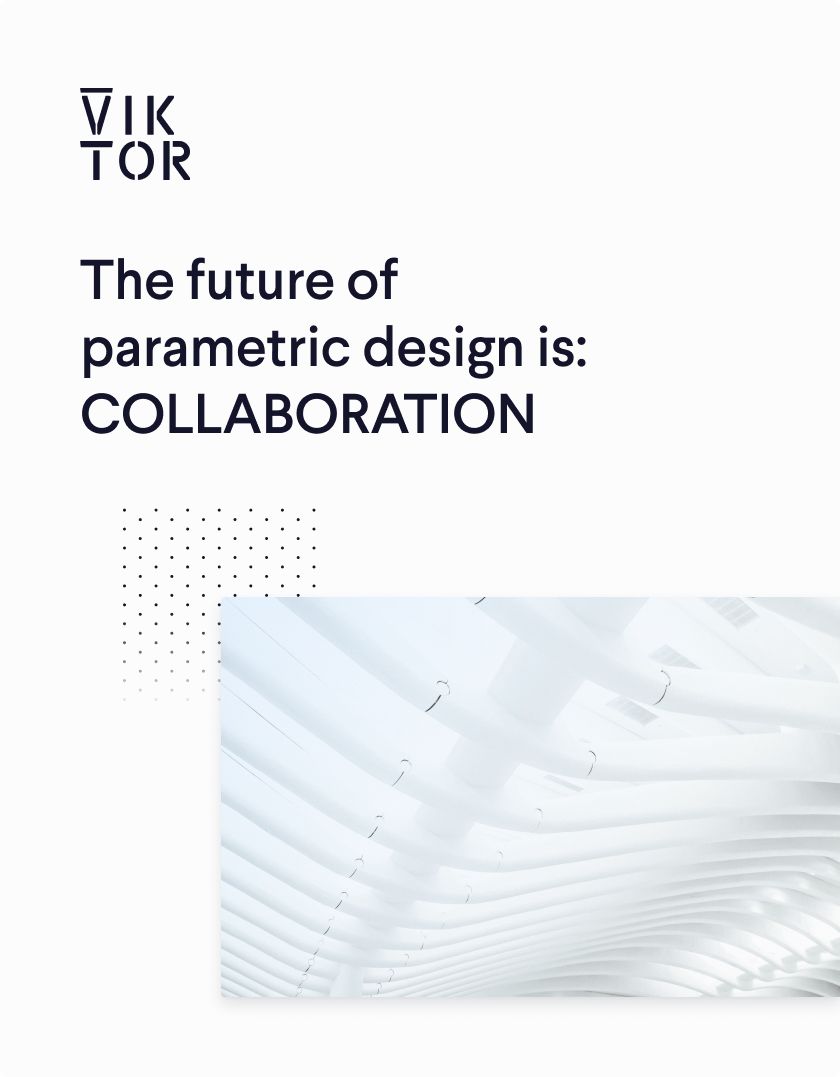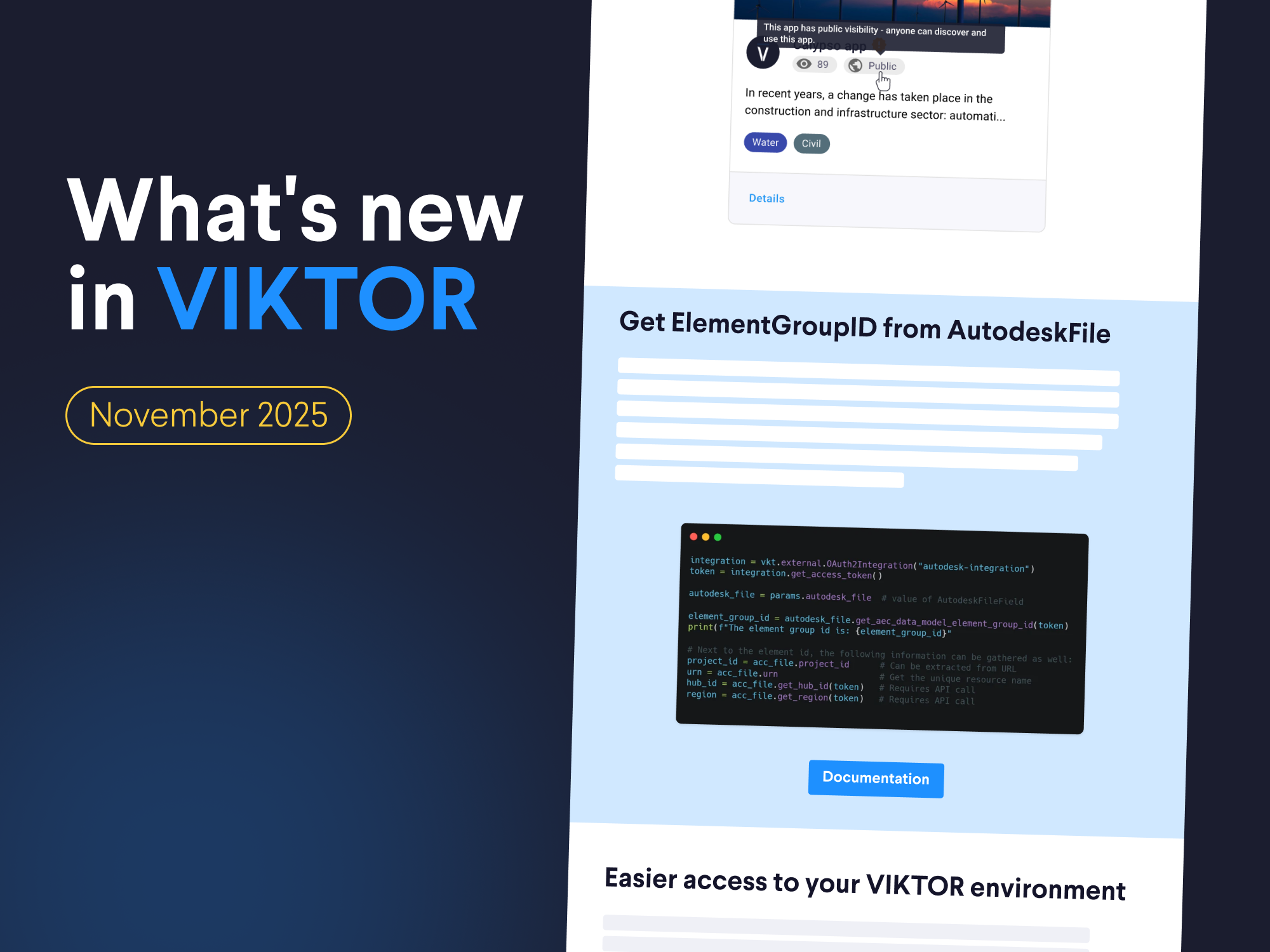April 14, 2021
Parametric design mitigates risks at the Rottemerentunnel

by VIKTOR


Download the white paper and get INSPIRED
Learn how collaborative parametric design models allow you to work together for better solutions.
Source: COB
A more flexible desing process
The immediate reason to look for a different way of designing stems from specific project circumstances. Kenneth Wyns: “Much of the soil investigation could only be done after trees had been felled and a pool had been filled in. That led to uncertainty. We were looking for more flexibility in the design process. That and the fact that there is a lot of repetition in the design of tunnel sections, made this approach attractive. The main goal was to make the design more location-specific. This allowed us to control the risk of delays due to unforeseen circumstances. The choice for parametric design means that after a change you can, as it were, recalculate the entire tunnel at the touch of a button. We really needed the desired flexibility in practice. We were only able to do the last CPTs in June. At the beginning of July we were able to calculate the last pile reactions, which allowed us to adjust the design of ten tunnel sections at a fairly late stage in the process. With this we have also been able to demonstrate that parametric design has value in practice. Normally the changes should be done manually. That takes more time and would certainly have meant that we should have shifted in the realization phase and that we would have had to call in extra capacity in a hurry.”
Acceleration of the design iteration
Parametric design is a process in which a design can be generated from a central online platform based on data or relationships between parts thereof. As the example of the Rottemerentunnel shows, the parametric process offers possibilities for new design possibilities. Because a design iteration can be completed more quickly, more space is also created for, for example, calculating alternative scenarios. That this would also mean that the entire design process could go faster, is not an issue, according to Kenneth. “There is a shift in activities. More effort in the preliminary phase means more flexibility in later phases, in which the consequences of changes in circumstances, insights or choices are often more radical.” Stijn Jansen: “It is quickly thought that parametric design means that the constructors can go home. But that is not at all what it is intended to do. What you want is to speed up the design iteration process. Normally, that process requires many different steps, where you have to make calculations in different software packages. That process does require the expertise of constructors, while, I charge, it is a process of punching numbers into the computer. That is not the work those experts are waiting for, and due to the manual adjustments, we also have to deal with a high error rate."
Parametric design to link software
Stijn points out the extra value that designers have to add: “With parametric design we link the different software used within a project, which makes it easier for a designer to calculate more variants or scenarios.” In order to actually be able to fully utilize such advantages in practice, a change in thinking is still needed, according to Kenneth’s response. “If calculating alternative scenarios is not in the client’s requirements, then it will not happen. For the Rottemerentunnel, the possible consequences of stopping groundwater extraction in the vicinity of the tunnel have been calculated. This was stated in the job requirements of Rijkswaterstaat. But that does not apply to management scenarios, for example."
Parametric design to anticipate changes
The core of the different way of thinking that is possible through parametric design, according to Stijn, is that you assume in advance that you will have to anticipate changes along the way. “A designer wants to record things and work from there. But it is inherent to projects like the Rottemerentunnel that things change. If you take that as a given, what can you do to deal with it properly in the implementation? There is the advantage. In practice, parametric design appears to have added value especially if a project has a repetitive element. The process is very suitable for dyke improvements, for example. For parties involved in such projects, applying parametric design is a ‘no-brainer’.”
“In practice, parametric design appears to have added value especially if a project has a repetitive element.”
The dilemma of implementing parametric design
Implementing parametric design is a tough organizational challenge. People are not easily inclined to give up their existing certainties. Stijn: “As a software developer, I see processes in this sector that I do not feel fit into the 21st century. At the same time, I understand that a sector where the risks are so great is somewhat behind. ” The two millennials knew they had some missionary work to do.
Generation gap
Kenneth: “After Stijn and I had explored the possibilities, we prepared a presentation about usefulness and necessity. We also had to give that presentation again later at the BESIX headquarters in Brussels. They really wanted to be sure that this way of working would yield something and would not actually increase the risks. We notice that there is resistance to validation of designs based on data. There you really see a difference between generations. We are the first generation to be brought up with the computer. To convince everyone, we still had to validate two tunnel sections in the traditional way. The results corresponded to the shadow model. The computer does not lie. But it is, as always, “bullshit in is bullshit out”. You have to ensure that people with the right expertise are involved in the input of the information and the testing of the application.”

Organizational challenges
The challenge is no less great within organizations. Constructors who normally do their own calculations now have to communicate to software developers what they need, and what should and what should not be parametric. Kenneth: “Software developers work in sprints of two weeks, followed by a test before the next sprint starts. This was new to our organization and requires different thinking patterns and communication skills from constructors. And we will have to get used to the idea that the longer the term, the greater the uncertainty. If, as with this project, thirteen two-week sprints are planned, it is difficult to predict what you will have at the end. It is a challenge for the developer to make an estimate for the project planning.”
Contrary to what is often thought, parametric design for a company like BESIX does not mean that other people are suddenly needed. Kenneth: “Our designers can concentrate more on their expertise, only the way of working changes. One condition is that you are willing to be open; no other technical skills are required.”
Learning from each other
Optimizing repetitive work involves a learning process within a project. Kenneth also sees opportunities in the future to learn from project to project. He sees a role for engineering firms in developing apps. Kenneth: “Engineering firms can start to think differently and look more at software solutions than at hours. Fortunately, that is already happening. Clients and contractors will have to work together to develop a different earnings model.” Stijn: “That is very much in line with what we are doing. We are now working with a number of large contractors on the development of what we have come to call digital building blocks, with which companies can work more efficiently. At VIKTOR we believe that we can make different parties in the chain work better together. Imagine that designers and implementation work together with such a tool and can view the effect of alternative solutions in real time. Then you arrive at better solutions, for example in further limiting environmental nuisance or finding more sustainable solutions.” Kenneth: “If we are challenged to work more circularly, we can use parametric design to compare new techniques with proven technology. With scenarios you can also test different solutions on aspects other than constructive safety.”
See how you can use parametric design to optimze processes as well.


